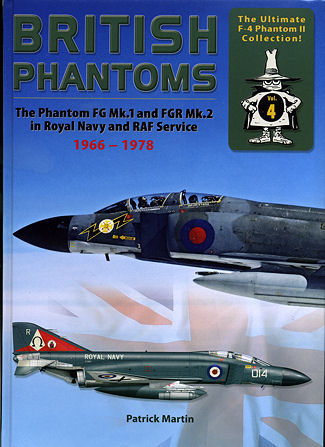Double Ugly Books: British Phantoms 1966-1978
|
BY: |
Patrick Martin |
|
PUBLISHER
/PRICE: |
Double Ugly Books, 2012
€39.95. Get yours
here. |
|
REVIEW BY: |
Scott
Van Aken |
|
NOTES: |
The Ultimate F-4 Phantom II
Collection Vol 4
ISBN: 978-3-935687-84-3 |
 One of the
more written about aircraft is the F-4 Phantom II. You can find books on the
aircraft from a variety of sources, but for the first time, there is a series of
books about the Phantom II in service with the various nations of the world. A
history of the type in the sort of depth that we have not seen before.
One of the
more written about aircraft is the F-4 Phantom II. You can find books on the
aircraft from a variety of sources, but for the first time, there is a series of
books about the Phantom II in service with the various nations of the world. A
history of the type in the sort of depth that we have not seen before.
Double Ugly Books, a subsidiary of Air Doc, has
started this series with one of the more interesting services to use the Phantom
II, the IDF/AF. This was followed by USN Atlantic squadrons and now we have a
fourth volume that cover the first dozen years of use by the RAF and the RN.
Actually, the cut off date corresponds with the last year of RN use as it
decommissioned its last full deck carrier in that year, relegating the RN's FG.1
homeless. I am sure that an upcoming volume will cover the remaining years.
To McDonnell-Douglas, the two British aircraft
were the F-4K and the F-4M. The F-4K was the navalized version and referred to
as the Phantom FG.1, while the F-4M was the RAF aircraft and called the Phantom
FGR.2. The major difference was that the FG.1 had equipment specifically for
carrier use, which included the hold back hooks and a nose gear that had an
additional 40 inch extension built in so that it was at the right angle of
attack to be launched from Britain's shorter carriers. Otherwise, they were
pretty much the same, which helped the type's integration into the RAF
post-1978.
The British Phantom had to have a certain
percentage of British equipment in it before the London government would buy the
plane. This is pretty standard stuff now as you have to keep the home shops
busy. Aside from avionics and seats, this meant Spey turbofan engines. These
engines were more powerful than the standard J-79 used by the F-4. They were
also larger and required a bigger intake opening and a redesign of the ducting
and areas around the engine. This increased the drag on the airframe so you
ended up with a Phantom that was more powerful, quicker accelerating and with a
slower top speed.
In line with other books in the series, we get a
full description of the development of the aircraft and its introduction into
squadron service. This is accompanied by a bevy of superb photographs and
drawings, just about all of them in full color. The images are not the tiny ones
several other books have provided, but generally cover the width of the page.
There are also a large number of full color profiles that match various images
in the book.
There are sections on the camouflage and markings
of the aircraft as well as one that covers each unit that flew the plane. A
small section on weapons is also included as are unit badges, and four views of
the various camo schemes carried by these planes.
It is a book that I can easily give my highest
recommendation and one that should be a must have for any enthusiast or
modeler of the Phantastic Phantom.
January 2013
My thanks to AirDoc for the review book. You can find these
at your local hobby shop and if not, ask them to order them for you. You can
also order direct by
visiting this link.
If you would like your product reviewed fairly and quickly, please contact
me or see other details in the Note to
Contributors.
 One of the
more written about aircraft is the F-4 Phantom II. You can find books on the
aircraft from a variety of sources, but for the first time, there is a series of
books about the Phantom II in service with the various nations of the world. A
history of the type in the sort of depth that we have not seen before.
One of the
more written about aircraft is the F-4 Phantom II. You can find books on the
aircraft from a variety of sources, but for the first time, there is a series of
books about the Phantom II in service with the various nations of the world. A
history of the type in the sort of depth that we have not seen before.